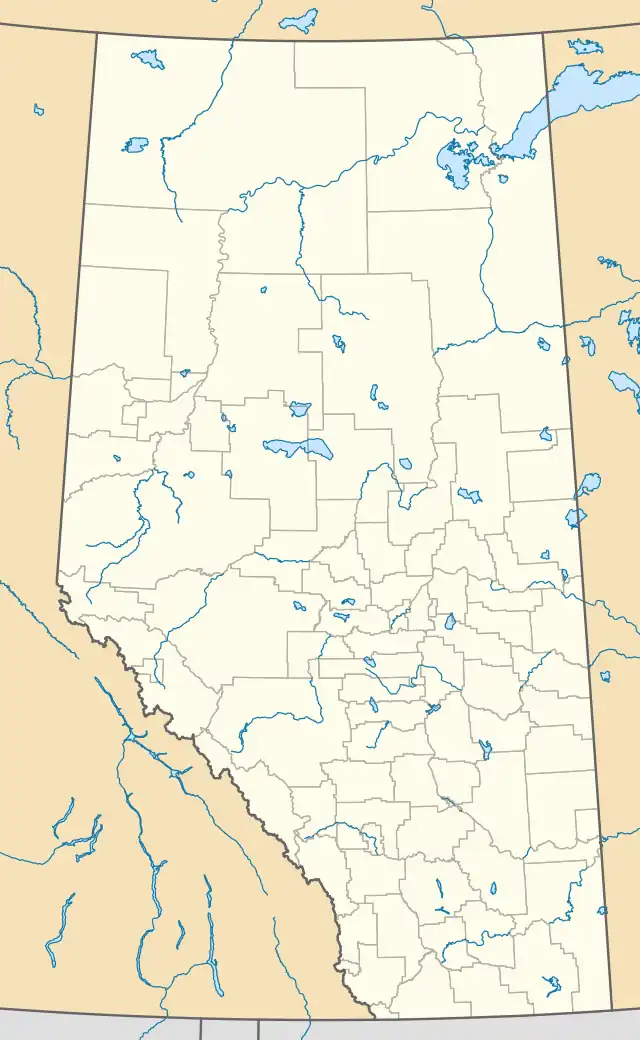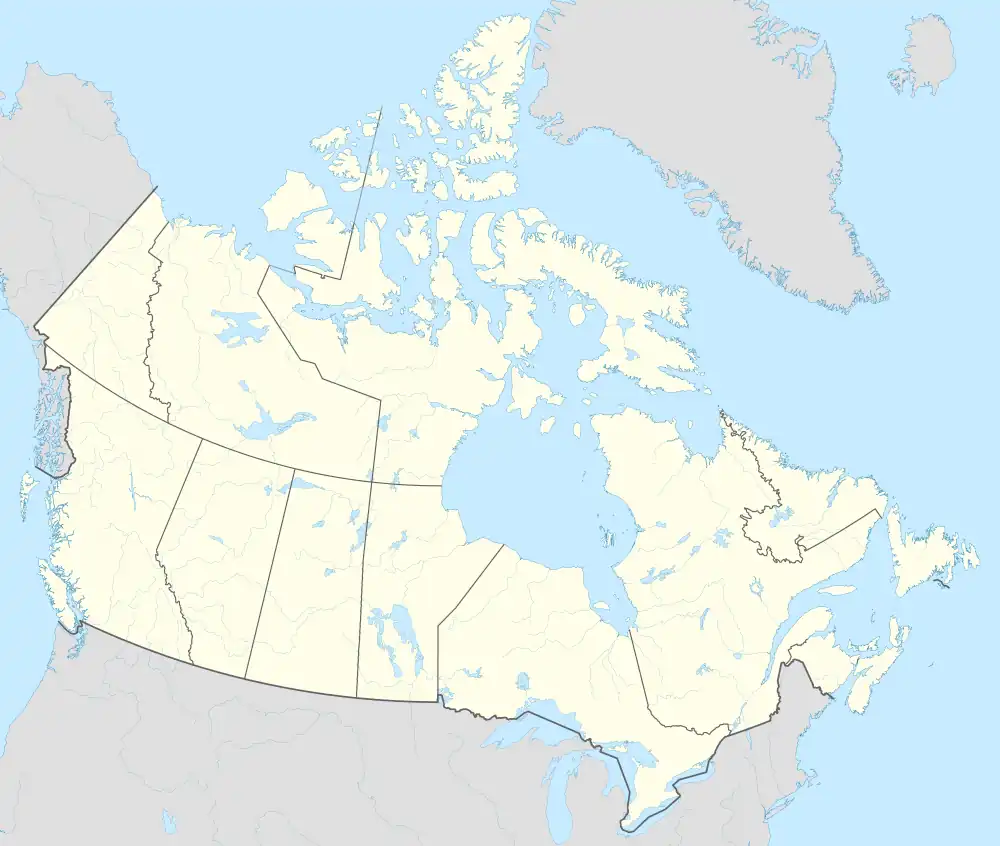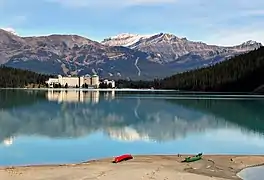Lake Louise | |
|---|---|
Hamlet | |
 Lake Louise, with which the hamlet shares its name, pictured in June 2018 | |
 Lake Louise Location of Lake Louise in Alberta  Lake Louise Lake Louise (Canada) | |
| Coordinates: 51°25′31″N 116°10′50″W / 51.42528°N 116.18056°W[1] | |
| Country | Canada |
| Province | Alberta |
| Region | Alberta's Rockies |
| Census division | No. 15 |
| Improvement district | Improvement District No. 9 |
| Government | |
| • Type | Unincorporated |
| • Governing body | Improvement District No. 9 Council |
| • MP | Blake Richards (C) |
| Elevation | 1,600 m (5,200 ft) |
| Population (2011)[4] | |
| • Total | 691 |
| Time zone | UTC−07:00 (MST) |
| • Summer (DST) | UTC−06:00 (MDT) |
| Postal code span | |
| Area code(s) | 403, 587 |
| Highways | |
Lake Louise is a hamlet within Banff National Park in Alberta, Canada. Named after Princess Louise, Duchess of Argyll, it lies in Alberta's Rockies on the Bow River, 3 km (1.9 mi) northeast of the lake that shares its name. Initially settled in 1884 as an outpost for the Canadian Pacific Railway, Lake Louise sits at an elevation of 1,600 m (5,200 ft), making it Canada's highest community. The nearby lake, framed by mountains, is one of the most famous mountain vistas in the world.
History

Prior to the arrival of Europeans, Indigenous peoples lived in the foothills and forests of the Rocky Mountains – including what is today Lake Louise – where they hunted bison and other big game animals. In the language of the Nakoda people, Lake Louise is called Ho-run-num-nay, meaning "lake of the little fishes".[5]
During the 1870s, the construction of the Canadian Pacific Railway (CPR) started. The railway was planned to run through Bow Valley. A Nakoda guide took CPR workman Tom Wilson to the site in 1882, and Wilson named it Emerald Lake. The hamlet was later called Holt City, and then Laggan, before being renamed Lake Louise. A ca. 1890 CPR station was replaced in 1910 but continued to be used by the railway company for other purposes until it was donated in 1976 to Heritage Park Historical Village in Calgary. The depot was moved to the park and restored to the era when the Lake Louise village was called Laggan.[6] The 1910 station was declared a heritage railway station by the federal government in 1991,[7] and has been preserved and today operates as a restaurant.[8]
Lake Louise was added to Rocky Mountains Park in 1892, and has since become a tourist destination made accessible by its location off the Trans-Canada Highway.
Geography

The hamlet is in Division No. 15, one of 19 census divisions of Alberta and the federal riding of Banff—Airdrie. It is beside the Trans-Canada Highway (Highway 1), 180 km (110 mi) west of Calgary.
The background of Lake Louise is filled with views of several snow-capped mountains, including Mount Temple, Mount Whyte, and Mount Niblock.
Climate
Lake Louise experiences a subarctic climate (Köppen climate classification Dfc). Annual snowfall averages 279.1 cm (109.9 in) and although winter temperatures can fall below −50 °C (−58 °F) in January and February the averages are −18.4 °C (−1.1 °F) and −17.6 °C (0.3 °F) respectively. Summers consist of frosty mornings and crisp, cool days. Snow can occur in any month of the year. Since lower elevations on said latitude have humid continental climates instead, it may also be described as a subalpine climate. Because of its high diurnal air temperature variation and high altitude, the frost-free period averages only 14 days.[9]
| Climate data for Lake Louise Climate ID: 3034480; coordinates 51°26′N 116°13′W / 51.433°N 116.217°W; elevation: 1,524 m (5,000 ft); 1981−2010 normals | |||||||||||||
|---|---|---|---|---|---|---|---|---|---|---|---|---|---|
| Month | Jan | Feb | Mar | Apr | May | Jun | Jul | Aug | Sep | Oct | Nov | Dec | Year |
| Record high °C (°F) | 7.8 (46.0) |
13.9 (57.0) |
17.0 (62.6) |
26.5 (79.7) |
31.7 (89.1) |
31.1 (88.0) |
34.4 (93.9) |
32.2 (90.0) |
29.0 (84.2) |
26.1 (79.0) |
18.3 (64.9) |
12.2 (54.0) |
34.4 (93.9) |
| Mean daily maximum °C (°F) | −5.4 (22.3) |
−1.7 (28.9) |
2.9 (37.2) |
7.5 (45.5) |
12.7 (54.9) |
16.7 (62.1) |
20.4 (68.7) |
20.1 (68.2) |
14.7 (58.5) |
7.3 (45.1) |
−1.7 (28.9) |
−6.9 (19.6) |
7.2 (45.0) |
| Daily mean °C (°F) | −12.0 (10.4) |
−9.7 (14.5) |
−4.7 (23.5) |
0.9 (33.6) |
5.8 (42.4) |
9.7 (49.5) |
12.6 (54.7) |
11.9 (53.4) |
7.1 (44.8) |
1.1 (34.0) |
−7.1 (19.2) |
−13.0 (8.6) |
0.2 (32.4) |
| Mean daily minimum °C (°F) | −18.4 (−1.1) |
−17.6 (0.3) |
−12.3 (9.9) |
−5.8 (21.6) |
−1.2 (29.8) |
2.8 (37.0) |
4.7 (40.5) |
3.6 (38.5) |
−0.5 (31.1) |
−5.1 (22.8) |
−12.6 (9.3) |
−19.1 (−2.4) |
−6.8 (19.8) |
| Record low °C (°F) | −52.8 (−63.0) |
−50.6 (−59.1) |
−44.4 (−47.9) |
−33.9 (−29.0) |
−27.8 (−18.0) |
−10.0 (14.0) |
−7.0 (19.4) |
−7.5 (18.5) |
−25.0 (−13.0) |
−32.0 (−25.6) |
−44.0 (−47.2) |
−49.4 (−56.9) |
−52.8 (−63.0) |
| Average precipitation mm (inches) | 52.4 (2.06) |
47.9 (1.89) |
37.3 (1.47) |
32.3 (1.27) |
59.9 (2.36) |
54.3 (2.14) |
56.4 (2.22) |
53.9 (2.12) |
41.9 (1.65) |
37.7 (1.48) |
57.4 (2.26) |
48.7 (1.92) |
543.8 (21.41) |
| Average rainfall mm (inches) | 0.7 (0.03) |
0.0 (0.0) |
1.5 (0.06) |
9.0 (0.35) |
32.8 (1.29) |
54.1 (2.13) |
56.4 (2.22) |
53.6 (2.11) |
39.1 (1.54) |
19.0 (0.75) |
2.4 (0.09) |
0.0 (0.0) |
268.7 (10.58) |
| Average snowfall cm (inches) | 51.3 (20.2) |
33.4 (13.1) |
36.4 (14.3) |
23.5 (9.3) |
7.1 (2.8) |
0.2 (0.1) |
0.0 (0.0) |
0.0 (0.0) |
2.8 (1.1) |
18.7 (7.4) |
57.0 (22.4) |
48.8 (19.2) |
279.1 (109.9) |
| Average precipitation days (≥ 0.2 mm) | 12.0 | 8.1 | 9.9 | 8.2 | 13.3 | 16.5 | 14.9 | 14.2 | 11.6 | 11.3 | 12.5 | 11.5 | 143.9 |
| Average rainy days (≥ 0.2 mm) | 0.1 | 0.0 | 0.38 | 2.6 | 11.9 | 16.5 | 14.9 | 14.2 | 11.2 | 6.1 | 0.5 | 0.0 | 78.3 |
| Average snowy days (≥ 0.2 cm) | 11.9 | 8.1 | 9.8 | 6.0 | 2.2 | 0.1 | 0.0 | 0.0 | 0.93 | 6.0 | 12.1 | 11.5 | 68.5 |
| Source: Environment and Climate Change Canada[9] | |||||||||||||
Demographics
Lake Louise recorded a population of 691 in the 2011 Census of Population conducted by Statistics Canada.[4] Residents often change year to year, with workers in the service and tourism industries moving to the area for work.[10]
Attractions
Lake Louise features a shopping centre named Samson Mall. Lake Louise Ski Resort, a downhill ski area, is located across Highway 1. Chateau Lake Louise is southwest of the community on the shores of the lake.
Government
Lake Louise is administered by Improvement District No. 9.[11]
Infrastructure
The Trans-Canada Highway (Highway 1) runs adjacent to the community while Highway 1A begins at the entrance to the community. The southern terminus of the Icefields Parkway (Highway 93) is just north of the community.
See also
References
- ↑ "Lake Louise". Geographical Names Data Base. Natural Resources Canada.
- "Lake Louise". Geographical Names Data Base. Natural Resources Canada.
- ↑ "Alberta Private Sewage Systems 2009 Standard of Practice Handbook: Appendix A.3 Alberta Design Data (A.3.A. Alberta Climate Design Data by Town)" (PDF) (PDF). Safety Codes Council. January 2012. pp. 212–215 (PDF pages 226–229). Archived from the original (PDF) on October 29, 2020. Retrieved October 8, 2013.
- 1 2 "Evaluation of Parks Canada's Townsite Management Sub-Program" (PDF). Parks Canada. January 11, 2017. p. 47. Retrieved April 16, 2020.
- ↑ Marsh, James H. "Lake Louise". The Canadian Encyclopedia. The Canadian Encyclopedia. Retrieved November 23, 2023.
- ↑ "Laggan Station". Heritage Park. Retrieved February 7, 2021.
- ↑ "Heritage Railway Station of Canada Lake Louise, Alberta". Historic Sites and Monuments Board of Canada. Retrieved July 4, 2012.
- ↑ "The Station Restaurant". Laggan Developments Ltd. Retrieved August 15, 2021.
- 1 2 "Lake Louise Canadian Climate Normals 1981-2010". climate.weather.gc.ca. Environment and Climate Change Canada. September 25, 2013. Retrieved February 2, 2020.
- ↑ Calgary Heritage Park. "Laggan Station". Retrieved June 10, 2012.
- ↑ Improvement District No. 9 (Banff) Archived 2007-09-15 at the Wayback Machine - Alberta Municipal Affairs
External links
 Lake Louise travel guide from Wikivoyage
Lake Louise travel guide from Wikivoyage
